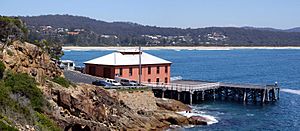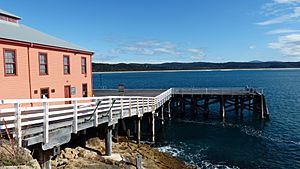Tathra Wharf facts for kids
Quick facts for kids Tathra Wharf |
|
|---|---|
 |
|
| Location | Wharf Road, Tathra, Bega Valley Shire, New South Wales, Australia |
| Built | 1860–1862 |
| Owner | Department of Planning and Infrastructure |
| Official name: Tathra Wharf and building | |
| Type | state heritage (built) |
| Designated | 2 April 1999 |
| Reference no. | 405 |
| Type | Wharf |
| Category | Transport - Water |
| Lua error in Module:Location_map at line 420: attempt to index field 'wikibase' (a nil value). | |
Tathra Wharf is a special old pier in Tathra, Australia. It was built a long time ago, between 1860 and 1862. This historic spot is now home to a museum and a cafe. The government of New South Wales owns and looks after this important place. It was officially added to the New South Wales State Heritage Register on 2 April 1999, meaning it's a protected historical site.
Contents
The Wharf's Early Days
The very first pier at Tathra was built around 1860-1861. It was a simple jetty that stretched out into the ocean. People called it the Farmer's Sea Wharf. But this first pier was quickly replaced. A new, stronger wharf was built over it in 1861–1862. This new structure was made from strong turpentine timber.
Why the Wharf Was Built
The wharf was needed because ships became a popular way to move goods. The Illawarra and South Coast Steam Navigation Company started in 1858. This meant more ships were sailing along the coast. The first cargo ship visited Tathra in 1858. It had to anchor offshore, and smaller boats carried the cargo to and from the beach.
Growing Bigger Over Time
The wharf was made longer and stronger many times. This happened in 1873, 1878, 1886, and 1889. These changes were needed as more ships visited and bigger ships arrived. Better building methods also helped improve the wharf.
In the early 1900s, the wharf kept growing.
- In 1901, special yards for cattle and pigs were added.
- The wharf was made even longer in 1903.
- In 1907, the main buildings were rebuilt into the two-story structure you see today.
At this time, new spring-loaded buffers were added. These helped large ships dock safely, especially when the sea was rough. A special mooring buoy was also placed nearby to help ships stay in position.
Choosing the Best Spot
The location of the wharf was chosen carefully. It's on the north side of a headland. This spot offers the best protection from strong winds and waves coming from the south.
Changes and Decline of Shipping
Between 1907 and 1912, the wharf had many more additions. These included a crane, a ramp for loading animals, and a shelter for passengers.
In 1919, the passenger shelter was replaced by a single-story shed. This showed that fewer people were traveling by sea. Instead, the focus was on moving goods and cargo.
Later, road transport became more common. This led to a big drop in shipping from the wharf. However, the South Coast was one of the last areas to be affected. This was because there was no railway line nearby to carry goods to Sydney. The very last ship to take cargo from Tathra left in 1954.
Saving the Historic Wharf
After 1954, the wharf was mainly used for fishing boats. In 1973, there was a plan to tear it down. But the local community and the National Trust of Australia (NSW) fought to save it. They raised money to restore the wharf.
Conservation work began and continued until 1988. The New South Wales government and the federal government also helped with funding. In 1978, a new group called the Tathra Wharf Trust was formed. This group now looks after the wharf. The wharf was officially reopened in 1988 after its restoration.
In 2002-2003, more money was given for repairs. The piers, beams, and platform were replaced in 2006. They used the same types of strong timber as before. The roof was also fixed at this time.
Recent Events at the Wharf
In June 2016, a big storm damaged the wharf buildings. The cafe had to close for six months for repairs.
In 2018, a large bushfire came very close to the wharf. Luckily, the site was not damaged.
Today, the restored wharf buildings are home to the Tathra Wharf Museum and a cafe.
What the Wharf Looks Like
The wharf is built mostly from strong timber. It has a timber deck and structures supported by timber piles. These piles go down to the rocky seabed.
At the end closest to the land, the wharf meets a stone and concrete wall. On the western side of the wharf, there are two timber buildings. The original two-story building is closer to the land. A single-story shed, built around 1900, is next to the larger building.
The big timber shed has interesting roof supports called trusses. All the timber parts are put together with traditional joints and metal fasteners. Both the wharf and the sheds show excellent craftsmanship from the time they were built.
The wharf sits on a small piece of land that sticks out into the sea. This spot offers great views along the coast. A road leads down to the wharf from the west.
The wharf is in excellent condition. It still looks much like it did when it was a busy shipping hub.
Why Tathra Wharf is Special
Tathra Wharf is very important because it's the only wharf and building combination left on the eastern coast of Australia from the 1860s shipping era. It helps us understand how coastal trade worked long ago.
- A Link to the Past: The wharf shows how important coastal shipping was for the growth of Tathra, Bega, and the surrounding areas. It's a rare example of how these old wharf complexes operated.
- Beautiful and Strong Design: It's a great example of a marine building made entirely from strong hardwood. The way it was built shows high quality and consistent design.
- Community Connection: The wharf is very important to the people of the Bega/Tathra area. The town of Tathra grew because of this port, and the wharf was central to life there for almost 100 years.
- Building Technology: The wharf and its buildings show how construction technology changed from the 1860s all the way to the 1950s.
- One of a Kind: It's unique because it's the only wharf and building combination from that period still standing on Australia's eastern coast.
- A Representative Example: The wharf is a good example of many similar piers that were built along the coast. It represents a way of transport and life that has now disappeared.
Tathra Wharf and its building were added to the New South Wales State Heritage Register on 2 April 1999.
Engineering Award
The wharf has been recognized as a National Engineering Landmark by Engineers Australia. This is part of their program to highlight important engineering achievements.
See also


